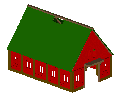This structure was identified entirely on the basis of the artefact distributions. There were no earth-fast timbers, and the structure presumably sat on a rectangular arrangement of sill-beams. Large concentrations of burnt clay with straw impressions, wood impressions, and impressions of overlapping planks and cross-members would indicate the presence of a structure, and the concentrations of pottery to the east and lead to the west would suggest the greatest extent of the structure in these directions. The sequence of destruction appears to consist of burning in situ, resulting in the baking and collapse of the clay daub from the planked walls, followed by the collapse of the structure to the south-west, resulting in the deposition of the lead which is assumed to have derived from the roof.
The reconstructions shown here are over-elaborate from the perspective of the excavators, but can still act as placemarkers in the final model.


© Internet Archaeology
URL: http://intarch.ac.uk/journal/issue8/huggett/jhreconscb.html
Last updated: Thu Jun 15 2000